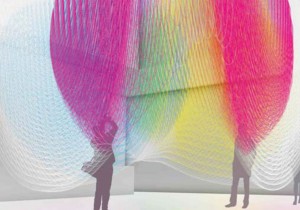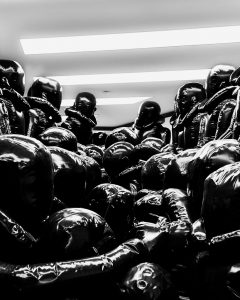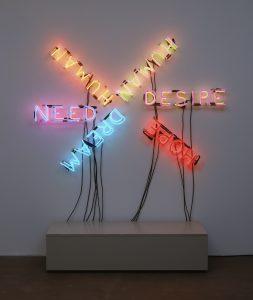
The Museum of Contemporary Art, Los Angeles (MOCA), presents Feathered Edge: A New Installation by Ball-Nogues Studio, on view July 26 through November 15, 2009, at MOCA Pacific Design Center. In this site-specific installation by the innovative Los Angeles–based design and fabrication firm led by Benjamin Ball and Gaston Nogues, 17 miles of colored strings configured in catenary curves span the gallery space to form a dynamic sculptural environment. Initiated by Brooke Hodge and coordinated by MOCA Curator Alma Ruiz, Feathered Edge underscores the artists’ continuing investigation of the convergence of digital technology and hand-craft techniques, as well as their interests in the processes and fabrication of automation and in affecting space using unconventional methods and materials.
The third in a series of projects that the designers loosely refer to as “Suspensions,” Feathered Edge is a sitespecific installation comprised of colored strings suspended as catenaries from the gallery’s double-height skylight. Each string is calculated to a slightly different length and is attached by hand to an ink jet printed mesh using a method inspired by the craft of latch-hook rug making. The Suspension installations evolved out of a desire to modulate space without utilizing solid forms. To accomplish this, the artists design both the artwork and the means to produce that artwork in an approach that they call “designing the production.” Recognizing the limitations of conventional architectural design software, they enlisted Pylon Technical to help develop custom parametric software that enables the designers to explore spatial configurations utilizing catenaries. The software simultaneously calculates the length and location for each string that is required to construct their desired form in a specific space. In the previous two Suspension installations, Echoes Converge (2008) and Unseen Current (2008), each string was cut by hand in preparation for hanging. For Feathered Edge, the artists mechanized the process of coloring and cutting the lengths of string by designing, fabricating, and programming a machine that precisely air brushes and quickly cuts each string to the prescribed length. In the artists’ own words, “We can now make something more intricate and larger. We can work faster and more efficiently in the fabrication phase so we can spend more time refining and studying the design, insuring it produces the right feeling.”







